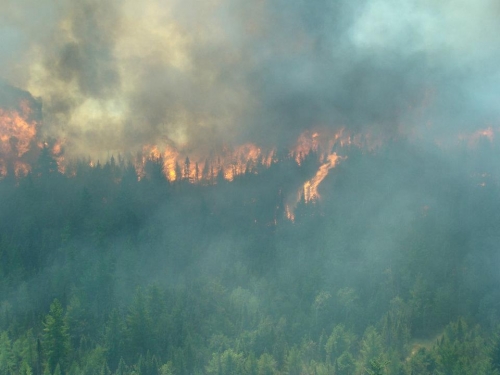Devastating wildfires sweep across Michigan’s Upper Peninsula
Homeowners need to adopt Firewise practices to help protect their structures in the face of these wildfire events.
Unseasonal dry conditions accompanied by lightning storms, little rainfall and high winds created conditions in which several wildfires flared up recently in the Upper Peninsula. From one storm alone, the Michigan Department of Natural Resources reported more than 27,000 lightning strikes.
The most devastating of the fires so far has been the Duck Lake Fire in Luce County just north of the town of Newberry. Started by a lightning strike, this fire ballooned up in a heavily forested area with challenging access. Spreading through dry woodlands and pushed by strong winds this blaze has ravaged more than 20,000 acres. More than 90 structures were consumed by the advancing blaze, including at least 34 homes, cabins and businesses.

Duck Lake Fire. Photo courtesy of Michigan DNR.
Evacuations were mandated as disaster planning was put into action. To date, there haven’t been any reported serious personal injuries or deaths associated with the Duck Lake Fire. Residents with homes in and adjacent to the fire were directed to local resource centers where they await news regarding the status of their homes and camps.
The loss of homes and businesses in this and any wildfire situation highlights the need for individual owners to undertake precautions to protect their property before disaster strikes. In spite of maximum efforts by responding agencies, they were overwhelmed by the magnitude of the fire and are unable to protect every structure in the path of a wildfire.
The national Firewise Communities program has information and suggestions to help homeowners and communities better prepare for wild land fires. These practices need to be considered and put into practice before fires begin. As evidenced by many in the Duck Lake Fire’s path, there isn’t time for any preventative efforts once the alarm to evacuate goes out.
To assist firefighters and first responders, homeowners should check to make sure their property is easily identified by nonflammable fire numbers or street addresses which are not blocked by vegetation. Driveways and access roads should be wide enough for two-way traffic or have turnouts constructed.
At a minimum in a 30’ perimeter around buildings easily combustible materials including needles, leaves, dead grass, firewood and dead trees need to be removed. Eaves and roofs need to be free of accumulations of needles or leaves. Trees touching or directly adjacent to structures should be removed. Thin out trees growing close to one another and prune all trees high enough to prevent ignition from ground fire.
Pine forests in general, and in Michigan jack pine forested areas in particular, present the greatest risk of loss from wildfire. In these areas more extreme efforts will probably need to be implemented to protect structures. In some cases, construction materials may be a consideration. Steel roofs, tempered glass, metal fences and fire resistant sidings all provide a greater measure of protection than more conventional materials.
As devastating as wildfires are, in most cases, the loss of structures in the face of these fires is preventable. Michigan State University (MSU) Extension has additional materials and suggestions to assist landowners.
Contact your local county MSU Extension office for assistance or visit the MSU Extension Firewise website.
For more information on what owners can do to protect their property, see “Northern Michigan cottage owners can protect their property from wildfire damage.”



 Print
Print Email
Email

